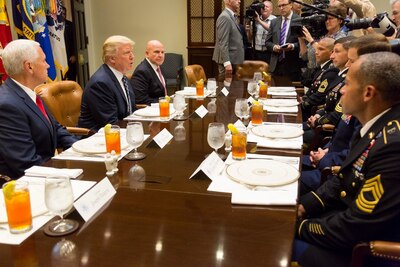National Security Advisor Hints at Basis of Trump’s National Security Strategy
WASHINGTON, Dec. 3, 2017 — During a speech to the Reagan National Defense Forum yesterday, President Donald J. Trump’s national security advisor gave hints on what the president’s national security strategy will contain.

Army Lt. Gen. H.R. McMaster, the first active-duty national security advisor since Army Gen. Colin Powell, said the strategy would set the stage for the country to reclaim its strategic confidence.
Making the speech at the Ronald Reagan Library in Simi Valley, California, was a tribute to the president who resurrected U.S. confidence when he took office in 1981. The 1970s were not a high point in American history. One president forced to resign, the loss in Vietnam, the Arab oil embargo and Iran breaking into the American embassy in Tehran and holding 55 American citizens hostage set the stage for Reagan’s presidency.
Confidence in the United States and the nation’s influence abroad were at a low point, McMaster said. “The Soviet Union appeared to be on the rise and America, it seemed, was in decline,” he said. “President Reagan ushered in a dramatic rethinking of America’s role in the world and a dramatic renewal of American confidence. America would not only triumph in the Cold War and beyond but reach a new height of influence and prosperity.”
It was also fitting to discuss the Trump administration’s national security strategy, which will be released shortly, since Reagan signed the first national security strategy in 1987, the general said.
Crossroads
“Today as we approach the unveiling of the Trump administration’s national security strategy, we are at a similar crossroads,” McMaster said.
Russia and China are subverting the post-World War II political, economic and security orders to advance their own interests at the expense of the United States and its allies, the national security advisor said.
Iran and North Korea are violating the sovereignty of their neighbors, pursuing weapons of mass destruction and exporting terror to other nations. “Jihadist terror organizations such as [the Islamic State of Iraq and Syria] threaten all civilized people in every corner of the world,” he said.
“These national security challenges also require a dramatic rethinking of American foreign policy from previous decades,” McMaster said.
The national security strategy “will focus on protecting our homeland, advancing American prosperity, preserving peace through strength … and finally enhancing American influence,” he said.
McMaster said the administration is reclaiming the strategic confidence necessary for implementing the strategy through understanding in four areas. “First, the values that define our nation; second, the full instruments that define our power; third, the threats facing our nation; and fourth, the dynamic and competitive nature of our security environment,” he said.
Instruments of Power
The values that define America are important. President Reagan called America “a shining city upon a hill” and spoke of the suffering of people living under fear and oppression. Americans believe in the value of every human life, McMaster said, and the world should know that is the case.
Trump’s actions have reinforced this, the general said. He ordered attacks on the Syrian airfield from which aircraft laden with chemical weapons launched attacks on their own people. “The president further demonstrated his commitments to American values with changes in the policies toward Cuba, Iran and Venuzuela,” he said.
Using all instruments of national power is at the heart of the strategy. “President Reagan understood that diplomacy and military force were both important and equally vital tools for national power,” McMaster said. “President Trump is aligning diplomatic, economic, military, informational, intelligence and law enforcement efforts since the first days.”
The South Asia strategy is a good example of this, he said. “We would no longer confuse activity with progress,” the general said. “Our military efforts and operations in the region combined with the efforts of our partners would focus on what brought us to Afghanistan in 2001 -- to deny terrorists safe havens that they could use to threaten America and threaten our allies.”
The administration is also clear about the threats facing America, McMaster said. These threats, he said, “emanate from revisionist powers, rogue regimes and jihadist terrorist organizations.”
The approach adopts a realistic view of our security environment, the general said. “For this reason, we do not base national security decisions on rigid ideology, but instead on our core national interests and clearly defined objectives derived from those interests,” McMaster said.
Finally, the approach seeks to understand the dynamic and competitive nature of the security environment. “We must acknowledge that the international system is, above all, characterized by competition, interaction and change,” he said.
The United States wants all nations to develop and compete, “but the competition must be fair,” McMaster said. “Our economic relationships will respect our partners sovereignty and their economic destinies, while ensuring American workers and American companies are not unfairly disadvantaged.”
(Follow Jim Garamone on Twitter: @GaramoneDODNews)